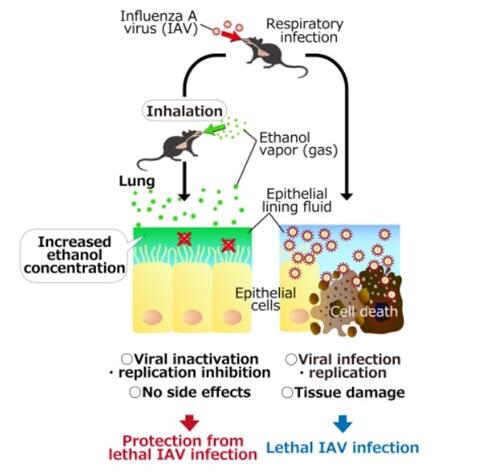A research group led by Professor Tsumoru Shintake of the Quantum Wave Microscopy Unit at the Okinawa Institute of Science and Technology (OIST), together with Associate Professor Hiroki Ishikawa and Dr. Miho Tamai of the OIST Immune Signal Unit, reported that they have observed that low‐concentration ethanol inhalation may be effective in treating respiratory virus infections.
The group verified in mice that the inhalation of low concentrations of ethanol vapor in the respiratory tract can inhibit influenza A infection without causing harmful side effects. This finding is expected to be broadly applicable to enveloped viruses, including emerging coronaviruses, and may lead to the development of preventive and therapeutic methods for these infectious diseases. The results were published in the April 26th issue of the Journal of Infectious Diseases.

Credit: Dr. Miho Tamai and Prof. Hiroki Ishikawa, provided by OIST
Both the novel coronavirus and seasonal influenza viruses are enveloped viruses. Ethanol inactivates these viruses by disrupting the lipid bilayer structure of their outermost shell. On the basis of the theory of phase change from a physical perspective (distillation), Tamai reported in 2020 that low‐concentration ethanol vapors at a temperature higher than that of the body, inhaled through the nose, could aggregate to a high concentration in the liquid phase on the surface of respiratory cells (such as the surface of airways) and inactivate viruses.
In this study, which was performed in collaboration with Ishikawa and his colleagues, the theory was tested biologically using both mice and human lung cell culture models. First, the safety of ethanol vapor inhalation was evaluated in mice. Using an ultrasonic vapor generator, mice in a chamber were sprayed with a 50% ethanol solution at 50 ℃ for 10 min, twice a day for 3 weeks.
Blood alcohol concentration increased immediately after spraying but quickly returned to normal. After 3 weeks, there was no loss of body weight and no liver damage. Next, mice were infected with influenza A virus via inoculation 5‐6 h before the experiment, and the survival rates were compared between mice that received ethanol vapor inhalation for 10 min twice daily and those that received water vapor inhalation in the same manner. Mice that inhaled ethanol vapor had significantly higher survival rates.
Using a human lung cell culture model, the researchers tested the cytotoxic effect of 20% ethanol treatment, which inactivates the virus at a body temperature of 37 ℃. No cytotoxicity was observed. Additionally, cultured lung cells were infected with influenza A virus to test for changes in virus levels with or without ethanol treatment.
The results showed a significant decrease in virus levels in the ethanol‐treated lung cells. This suggests that the virus particles produced by the infected cells were inactivated when they exited the cells, preventing re‐infection. It is estimated that exposure of the airways to 20% ethanol can be accomplished with the inhalation of 4% ethanol. By using a nebulizer to inhale ethanol twice a day, medical and nursing staff, as well as others may be able to avoid virus infections. The researchers warned against adding ethanol to humidifiers, not only because it is ineffective but also because of the risk of explosion.
Ishikawa commented, "We are currently preparing clinical trials to confirm the effect in humans. We want to confirm the safety of nebulized inhalation and its effects on influenza viruses and coronaviruses. We also hope to confirm its efficacy against avian influenza."
This article has been translated by JST with permission from The Science News Ltd. (https://sci-news.co.jp/). Unauthorized reproduction of the article and photographs is prohibited.




